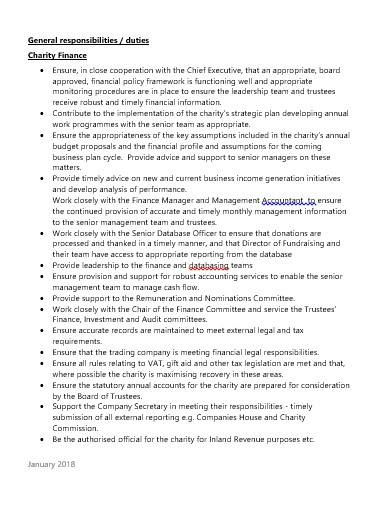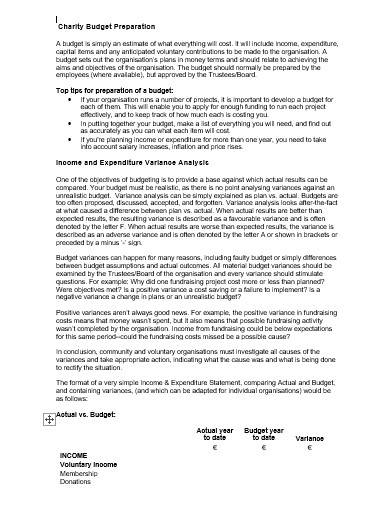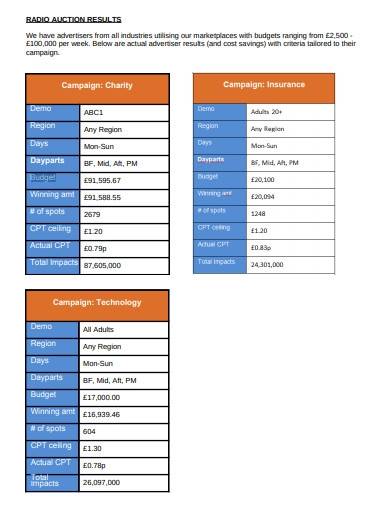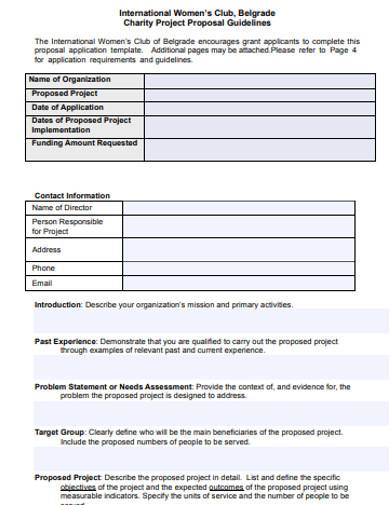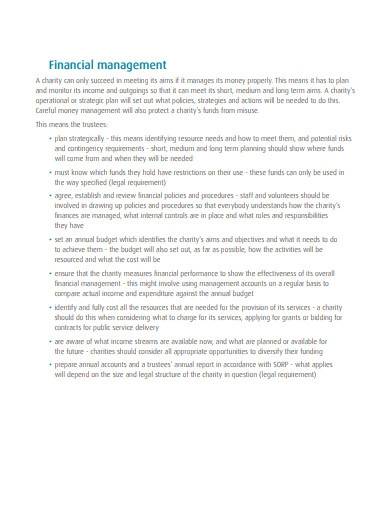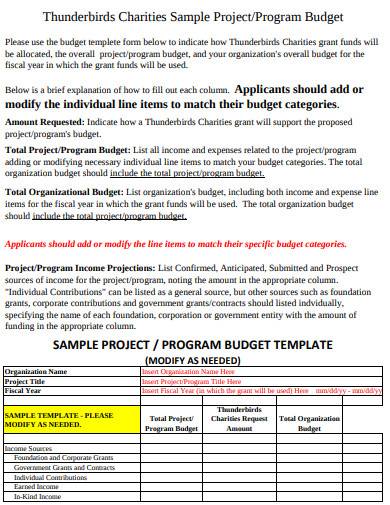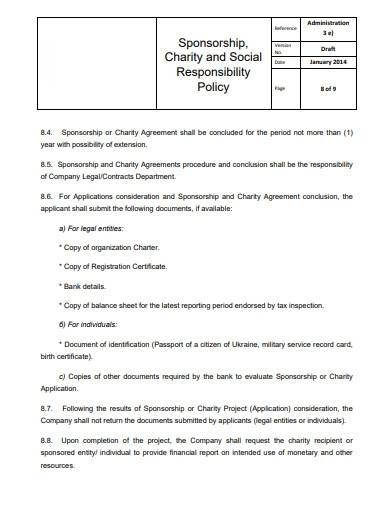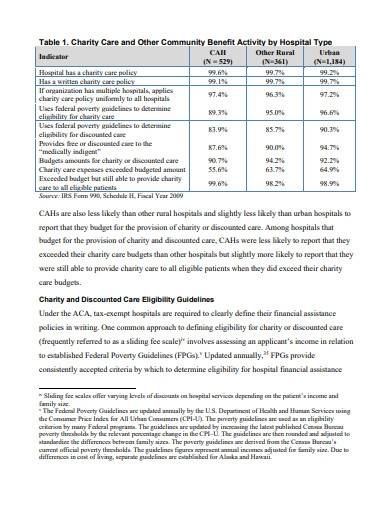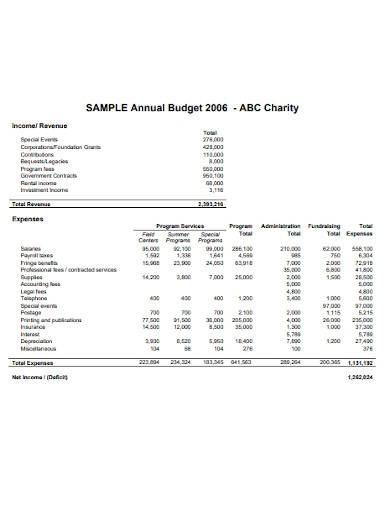Most of the time, you are in control over your cash, and no one could ever tell when you will spend more than usual. Not knowing, overspending is becoming a perpetuating issue, unseen and unconsidered. The best way around this is financial management and personal budgeting. These have long been considered useful not only to individuals but also organizations. Even a non-profit organization like a charity has to master the techniques of budgeting so that it can optimize its financial resources to the fullest. At its heart, a charity budget is a financial plan that presents the breakdown of expenses considering the number of assets of the organization. If you want to know more about a charity budget and how it affects the organization, you will find out in this article. Continue reading below.
FREE 10+ Charity Budget Samples & Templates in MS Word | PDF
1. Charity Budget Template
2. Sample Charity Budget Preparation
3. Charity Project Budget Template
4. Charity Tax Budget Template
5. Sample Charity Budget
6. Charity Project Budget Proposal Guideline
7. Basic Charity Management Budget
8. Sample Charities Project/Program Budget
9. Charity Sponsor Budget Format
10. Sample Community Charity Budget
11. Annual Charity Budget Template
What Is a Budget Plan?
A budget plan is a process of budgeting your money. With this spending plan, you can anticipate whether you will have enough financial resources to execute ideas or not. If you do not have enough money for your expenses, then use the budget plan to focus on your priorities. These are things that are more important and urgent. Without a budget plan, ensuring enough cash for what you need is unimaginable. You can even use a budget plan to prevent committing debt or make your way out of it.
Simply put, budgeting is balancing what you spend with what you have. Once that balance is interrupted, you will have to deal with financial issues. You should not spend more than what you earn, or financial stability is just a dream long overdue.
Charity Budget: How Is It Important?
Knowing that charities rely on donations, it can be said that without donors, these organizations will have a difficult time with operations and promotions. According to The Conversation, donors who give charitable giving for non-profit organizations often make them easier to expect, to plan, and to pace their finances. However, charitable giving by individuals is approaching rock bottom in the past years. On a report posted by Giving USA, the giving decreased by 1.7%, with 427.71 billion US dollars in 2018. This result is not unusual since a survey from the University of Michigan shown that Americans who donate money to charities downed to 53.1% in 2016 from 67.7% in 2002. Though the result will take time to approach zero, organizations should budget their funds to remain its operations and avoid debts.
Foundation Giving Peaked in 2018
Amidst the inflation, some foundations in the United States continued their philanthropic donations. Based on a survey reported by Giving USA, a source of reliable reports of its kind, 2018 is the record-breaking year for giving by foundations. It recorded the largest share (18%) contributed by US-based foundations—that was 76.98 billion US dollar part of estimated American Charitable giving, which was 427.71 billion US dollars in 2018.
How to Make a Charity Budget
Like charity membership form, donation letter, formal letter, and sponsorship form, a budget report is vital to charities. When managing finances, especially the ones belonging to an organization, make sure that everything is carefully and thoroughly done. In doing this, you need to be strongly disciplined to control unnecessary spending. Think of the organization’s future needs instead of the easy-to-get rewards to prioritize more important things. If you want to be successful with your budget plan, let us take you in-depth in making one. Here is how:
1. Identify Your Source of Income
Before starting the charity budget plan, check the source of your finances first. This can come from fundraisers, fundraising events, foundation giving, or individual donations. It is important to know where your money is coming from so that you can access it whenever. Also, knowing the source of your finances will make it easier to collate the number of your assets. From there, you can start categorizing the budget plan and designate the finances to which category it falls under. This way, you can divide your money according to the needs of each category. You can even define each category to organize the charity budget sheet.
2. Monitor Your Expenses
Apart from keeping an on the money flowing in, make sure you monitor the cash going out of the organization. In short, track your expenses. It can be taken from your bills, spending, debt, credits, and liabilities. If there are no expenses listed, you might expect that your income is allocated only for charitable works. The truth is, all these will be deducted from your income, so make sure it is included in your sample budget plan. Later on, you will know why there is a need to monitor your expenses.
3. Calculate the Total Income and Expenses
The charity budget has given you a reason to keep an eye on your income and expenses within a particular time. Thoroughly record all transactions made by the organization that involves cash. Do not miss out on any of it. This way, you have proven your funds to be existent. After that, get the total number of your income, likewise, expenses. Take note of these results and proceed to compare and to balance your data.
4. Compare and Balance the Results
Monitoring your expenses is crucial for the charity budget. Why? It will lead you to a plan. Since you have calculated your total income and spending, take the time to compare these accounts. A healthy financial condition is determined from a balanced budget plan. This means the organization’s expenses should not approach the number of income. However, if that happens, adjust your plan. Do this by channel cash into a more important category. It will ensure that your money is enough for your budget.
FAQs
What makes budgeting different from saving?
The only similar thing with budgeting and saving is that they involve money. Budgeting is allocating money for expected expenses. On the other hand, saving is setting aside part of your monetary resources for future spending.
Why is it important to budget?
With a budget, you can assure financial security by managing finances. With this, an individual or an organization will be successful in their undertakings, money-wise.
What is the difference between budgeting and financial planning?
Budgeting is a process that tests the weekly, monthly, or annual expenditures and income of an organization. In contrast, financial planning is optimizing the finances of any organization to project cash flow and the number of assets.
A successful budget does not necessarily mean it provides the largest amount of budget. It just merely tells you to balance what you have to what you are going to spend. Having a balance charity budget is all you need to gain the things that will help your organization strive and succeed.
Related Posts
FREE 3+ Charity Cheque Samples and Templates in PDF
FREE 10+ Charity Registration Form Samples & Templates in MS ...
FREE 10+ Charity Donation Receipt Samples & Templates in PDF
FREE 6+ Charity Fundraising Policy Samples & Templates in MS ...
FREE 10+ Charity Data Protection Policy Samples & Templates in ...
FREE 10+ Charity Volunteer Policy Samples & Templates in MS ...
FREE 10+ Charity Donation Policy Samples and Templates in MS ...
FREE 8+ Non Profit Balance Sheet Templates in MS Word PDF
FREE 10+ Charity Sponsorship Form Samples & Templates in MS ...
FREE 3+ Charity Employment Contract Samples and Templates in ...
FREE 15+ Charity Thank-You Letter Samples & Templates in PDF ...
FREE 10+ Charity Profile Samples & Templates in MS Word PDF
FREE 10+ Charity Fundraising Letter Samples & Templates in MS ...
FREE 10+ Charity Agreement Samples and Templates in PDF MS ...
FREE 10+ Charity Donation Thank You Letter Samples & Templates ...

